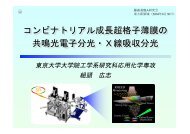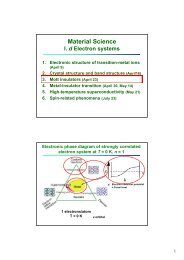Thesis High-Resolution Photoemission Study of Kondo Insulators ...
Thesis High-Resolution Photoemission Study of Kondo Insulators ...
Thesis High-Resolution Photoemission Study of Kondo Insulators ...
You also want an ePaper? Increase the reach of your titles
YUMPU automatically turns print PDFs into web optimized ePapers that Google loves.
4.3. Results and Discussion 51<br />
spectrum <strong>of</strong> YbB12 while larger Gaussian broadening was needed for Yb0.5Lu0.5B12. The<br />
fits show that the peak position is ∼ 23 meV below EF for YbB12 and ∼ 31 meV for<br />
Yb0.5Lu0.5B12.<br />
We compare the He I spectra <strong>of</strong> YbB12, Yb0.5Lu0.5B12 and LuB12 1 in the upper<br />
panel <strong>of</strong> Fig. 4.7. The figure reveals a gradual recovery <strong>of</strong> the missing spectral weight in<br />
the B 2p density <strong>of</strong> states (DOS) around EF as Lu is substituted for Yb. Note that the<br />
spectral change occurs in a rather wide energy range <strong>of</strong> ∼ 40 meV, in comparison with<br />
the transport activation energy <strong>of</strong> YbB12 (∼ 6 meV). The spectrum <strong>of</strong> LuB12 could<br />
be fitted to a linearly varying DOS multiplied by the Fermi distribution function <strong>of</strong><br />
30 K as shown in the lower panel <strong>of</strong> Fig. 4.7; the solid curves in the upper panel are<br />
convolutions <strong>of</strong> the DOS curves in the lower panel with the instrumental resolution.<br />
The DOS curves employed to fit the spectra <strong>of</strong> Yb0.5Lu0.5B12 and YbB12 have a dip or<br />
pseudogap (produced by subtracting Gaussians from the linear DOS) around EF . The<br />
spectral intensity at EF for YbB12 thus turned out to be depressed by ∼ 25% compared<br />
to LuB12. Attempt to fit the spectra with a small (a few meV) but fully opened gap at<br />
EF has been unsuccessful.<br />
The relationship between the “pseudogap” <strong>of</strong> the ∼ 40 meV width and the ∼ 6 meV<br />
transport gap is not clear at present. A recent electron tunneling study <strong>of</strong> SmB6, which<br />
is another <strong>Kondo</strong> insulator with a transport activation energy <strong>of</strong> ∼ 4 meV [4.19], has<br />
revealed a broad dip <strong>of</strong> ∼ 40 meV width around EF [4.20]. Such a dip or pseudogap<br />
might be a characteristic feature <strong>of</strong> the <strong>Kondo</strong> insulators.<br />
In the framework <strong>of</strong> the Anderson-impurity model (AIM), the properties <strong>of</strong> an Yb<br />
ion in the <strong>Kondo</strong> singlet ground state are described by [4.7]<br />
δ = B exp(− πε0f Nf∆ ), ¯nf = ∆<br />
∆ + πδ , (4.1)<br />
Nf<br />
to lowest order in 1/Nf with Uff = ∞, where δ ≡ kBTK is the <strong>Kondo</strong> peak position<br />
in the PES spectra, B is the conduction-band width above EF , ε0 f is the bare<br />
f (f 13 → f 14 ) level measured from EF (ε0 f > 0), Nf =8 is the degeneracy <strong>of</strong> the<br />
4f7/2 level and ¯nf denotes the f-hole occupancy. We define the hybridization strength<br />
1 We have normalized these spectra to the intensity around ∼ 0.1 eV to discuss only the vicinity <strong>of</strong><br />
EF . On the other hand, in Chap. 6 we normalize the He I spectra <strong>of</strong> Yb1−xLuxB12 single crystals to<br />
the integrated intensity between 200 meV and 260 meV. Comparison between poly- and single-crystal<br />
spectra are shown in Chap. 6.






